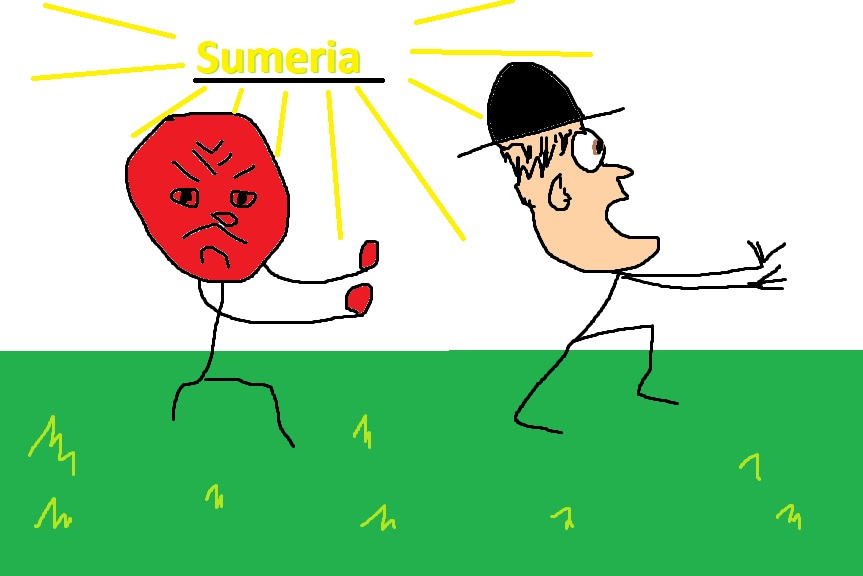Sumer: the "black-headed" vs. the "red-faced"
The Sumerian creation myth, discovered on a tablet in Nippur, an ancient Mesopotamian city founded in approximately 5000 BC, begins like this:
When in the height heaven was not named,
And the earth beneath did not yet bear a name,
And the primeval Apsu, who begat them,
And chaos, Tiamut, the mother of them both
Their waters were mingled together,
And no field was formed, no marsh was to be seen;
When of the gods none had been called into being,
And none bore a name, and no destinies were ordained;
Then were created the gods in the midst of heaven... Around 5400 BCE, settlers arriving from no one knows where, speaking a language that was a linguistic isolate (not related to any other known languages), which also happens to be the oldest known written language on earth, founded Eridu, a city in southern Mesopotamia (on the territory of present-day Iraq) which is generally regarded by today's historians to have been the world’s first city. It didn't appear to gradually change from something primitively city-like to a full blown city -- on the contrary, from the get-go it had absolutely everything we associate with an ancient city: temples, administrative buildings, housing, agriculture, markets, astronomy and mathematics and art, and, of course, walls. The Sumerian people were also an ethnic isolate, and intermixed with other populations of the area only a couple thousand years later, after Akkadian conquests which ultimately created a "melting pot." Sumerians and Akkadians, though they did continue to live in the same cities but in their own distinct communities, both referred to themselves as the sag gigga (“black-headed people”) and didn't have a concept of race, nor any prohibitions on intermarriage. Which seems to have gradually become common enough to eventually erase all traces of Sumerian-proper DNA from the human genetic pool -- at least none can be clearly identified at present. No one knows what they looked like either, since their surviving art is so eclectic and presented so many human and non-human versions of their self-portraits that it's of no help. It is not known if the term sag gigga, "black-headed," refers to hair color at all, since they also had a term for the "uncivilized" peoples surrounding them that literally means "red-faced," much like what European settlers dubbed Native Americans, referring not so much to the actual skin color (which was never really "red") but to the -- well, everybody knows what. "Black-headed" may have been a reference not to the appearance but, e.g., to the custom of wearing a hat (or some other head covering) for sun protection common in those who didn't live in a forest; while "red-faced" distinguished those who did still live in the forest, and therefore didn't need sun-protection contraptions. All that is known (from multiple clay tablets with extensive accounts of everything under Sumerian sun) about the relationship between the black-headed and the red-faced is that the black-headed did not discriminate against other black-headed, i.e. they accepted anyone civilized as equal, and simultaneously hated, rejected, and relentlessly killed all "red-faced," "wild," non-civilized people around their cities. The raids to exterminate the "uncivilized" were a regular and common feature of the civilized lifestyle of the area for thousands of years. And so begins the thread aiming to tackle Sumer without any references to Sitchin and staying only with the "accepted" "orthodox" "mainstream" etc. sources -- in an attempt to figure out if an overview of those "legitimized" sources might be sufficient to draw any non-legitimized conclusions about what the original creators of our present lifestyle were really up to -- before trying to jump to any conclusions regarding who they were.
And the earth beneath did not yet bear a name,
And the primeval Apsu, who begat them,
And chaos, Tiamut, the mother of them both
Their waters were mingled together,
And no field was formed, no marsh was to be seen;
When of the gods none had been called into being,
And none bore a name, and no destinies were ordained;
Then were created the gods in the midst of heaven... Around 5400 BCE, settlers arriving from no one knows where, speaking a language that was a linguistic isolate (not related to any other known languages), which also happens to be the oldest known written language on earth, founded Eridu, a city in southern Mesopotamia (on the territory of present-day Iraq) which is generally regarded by today's historians to have been the world’s first city. It didn't appear to gradually change from something primitively city-like to a full blown city -- on the contrary, from the get-go it had absolutely everything we associate with an ancient city: temples, administrative buildings, housing, agriculture, markets, astronomy and mathematics and art, and, of course, walls. The Sumerian people were also an ethnic isolate, and intermixed with other populations of the area only a couple thousand years later, after Akkadian conquests which ultimately created a "melting pot." Sumerians and Akkadians, though they did continue to live in the same cities but in their own distinct communities, both referred to themselves as the sag gigga (“black-headed people”) and didn't have a concept of race, nor any prohibitions on intermarriage. Which seems to have gradually become common enough to eventually erase all traces of Sumerian-proper DNA from the human genetic pool -- at least none can be clearly identified at present. No one knows what they looked like either, since their surviving art is so eclectic and presented so many human and non-human versions of their self-portraits that it's of no help. It is not known if the term sag gigga, "black-headed," refers to hair color at all, since they also had a term for the "uncivilized" peoples surrounding them that literally means "red-faced," much like what European settlers dubbed Native Americans, referring not so much to the actual skin color (which was never really "red") but to the -- well, everybody knows what. "Black-headed" may have been a reference not to the appearance but, e.g., to the custom of wearing a hat (or some other head covering) for sun protection common in those who didn't live in a forest; while "red-faced" distinguished those who did still live in the forest, and therefore didn't need sun-protection contraptions. All that is known (from multiple clay tablets with extensive accounts of everything under Sumerian sun) about the relationship between the black-headed and the red-faced is that the black-headed did not discriminate against other black-headed, i.e. they accepted anyone civilized as equal, and simultaneously hated, rejected, and relentlessly killed all "red-faced," "wild," non-civilized people around their cities. The raids to exterminate the "uncivilized" were a regular and common feature of the civilized lifestyle of the area for thousands of years. And so begins the thread aiming to tackle Sumer without any references to Sitchin and staying only with the "accepted" "orthodox" "mainstream" etc. sources -- in an attempt to figure out if an overview of those "legitimized" sources might be sufficient to draw any non-legitimized conclusions about what the original creators of our present lifestyle were really up to -- before trying to jump to any conclusions regarding who they were.
-
-
- 686 replies



